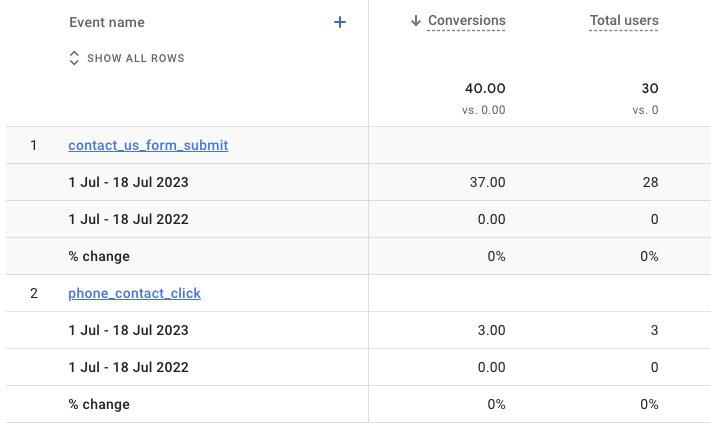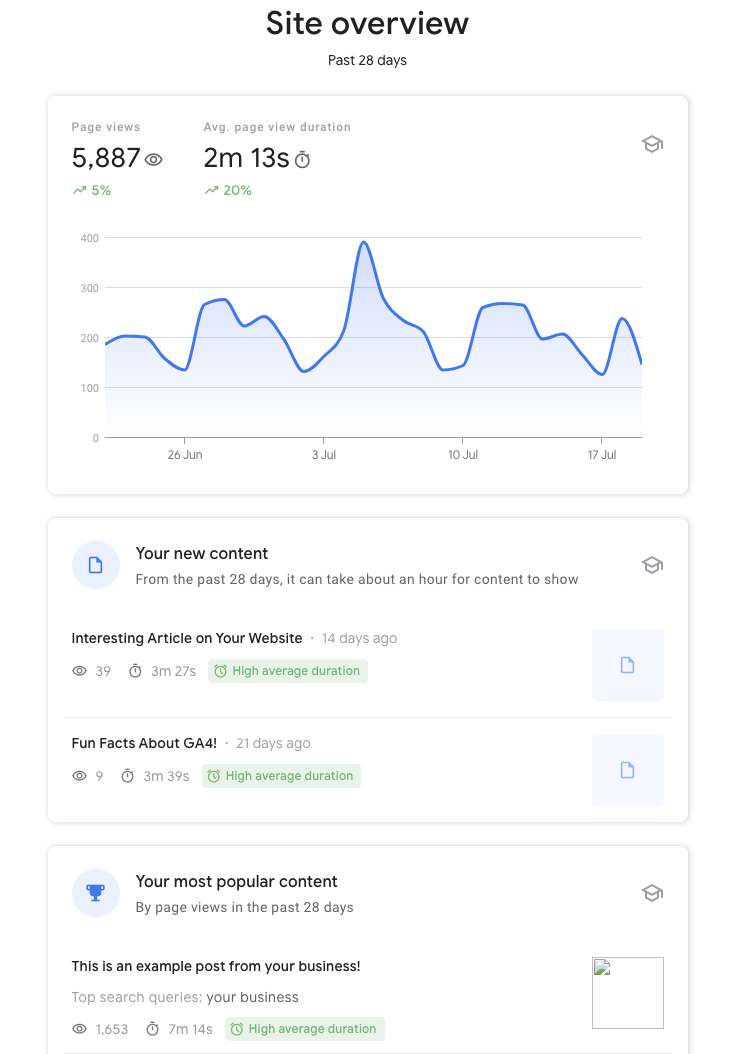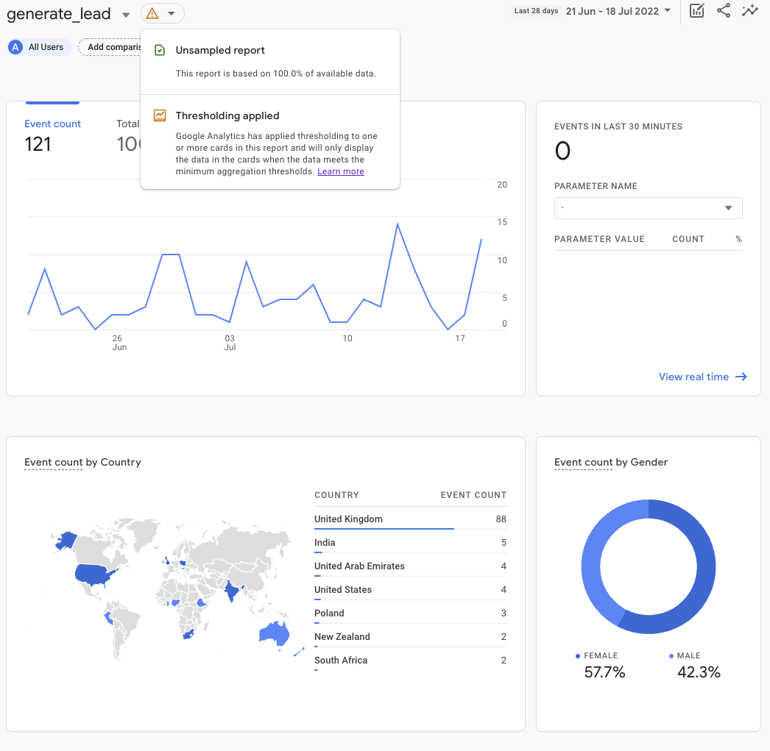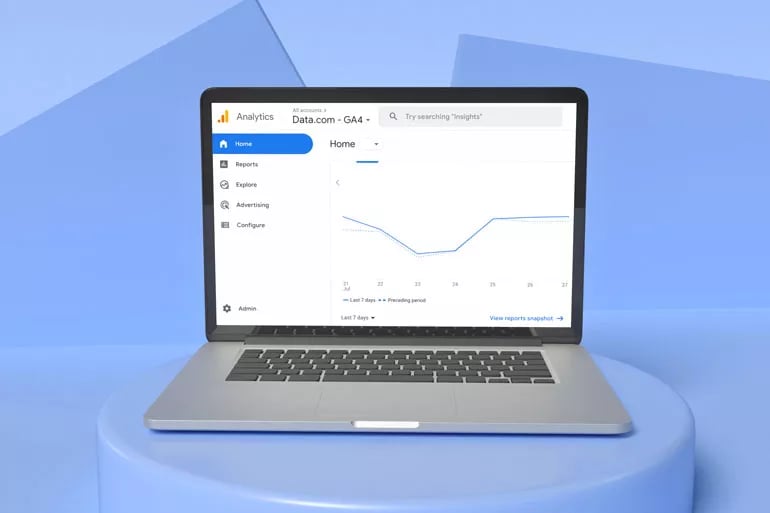Google Analytics 4 (GA4) is the latest property type available to Google Analytics users and is the successor to the popular Universal Analytics (UA) property. As discussed in our previous blog post, What is GA4 & How Will It Impact Your Business?, GA4 uses an event-based data model to track its user’s actions, and utilises “Data Streams” to connect all your data sources, such as website, iOS or Android apps, into one single property. GA4 aims to be more user-friendly by supplying you with a handful of automatically tracked events and “Enhanced Measurement” tracking, to automatically measure interactions and content on your site, such as file downloads, scrolls, etc., without the need for additional tracking code.
Why is GA4 Important?
“I already have a Universal Analytics account setup for my business, do I need to worry about GA4?”
The answer is yes, you definitely do.
Google plans to stop processing new hits within Universal Analytics properties by the 1st July 2023, leaving a further 6-month window where you can access and view this data. This means that come July 2023, if you do not have a GA4 property set up, you will have no new data to assess the performance of your website with. However, July 2023 isn’t the only deadline date you need to think about.
The importance of getting a GA4 property setup before this date is clear and simple – it’s data. Let’s imagine it is July 2023 right now, and you want to compare the performance of a page on your website to its performance both last month and last year, Universal Analytics is no longer collecting new data and you must now rely on GA4. If you had only set up your GA4 property in July 2023, then you are unable to make these comparisons since the data doesn’t exist. However, if you set up your GA4 property now, you’ll have a whole year of data ready and waiting to use already
Furthermore, the sooner you start embracing GA4, the quicker you will gain confidence in using the property and interpreting your business’ data. Universal Analytics’ interface shares some similarities with GA4, yet it is also vastly different, so it’s well worth taking the time to get acquainted with it now, whilst simultaneously capturing data for your business that can be used for future insight.

What your data may look like if you don’t act now. Note the lack of Year-on-Year comparison available.
What Has Changed Since Google Announced the Transition to GA4?
Although first introduced in October 2020, GA4 is still seen as a work-in-progress. Some features you regularly interact with may no longer be present, but this doesn’t necessarily mean they are gone for good. Google are still releasing regular updates and making changes to GA4 to continuously improve upon its offerings. Some recent changes and useful discoveries include:
Bounce Rate
Bounce rate was a commonly used feature within Universal Analytics that was missing from GA4 upon initial launch. This has recently been added into the latest property type, viewable within Explorations and Reporting Customisation, allowing you to view the percentage of sessions that were not engaged. GA4 have also created Engagement Rate which is the exact opposite of Bounce Rate.
UTM Term & UTM Ad Content
New dimensions now exist within the Exploration, Reporting and Audience Builder pages to view utm_content and utm_term parameter values. This allows for greater breakdown and analysis of your content which you have assigned UTM parameters to. Check out our article for Setting Up Your Google Analytics Account For Best Results, to learn more about the function of UTMs.
Session Conversion Rate
Reporting on the conversion rate for any conversion event is now possible within GA4, thanks to two newly added metrics: User Conversion Rate and Session Conversion Rate. Your conversion rates give you an insight into the average number of conversions per user or session, show as a percentage, and is calculated by dividing the total number of conversions by the total number of sessions/users, as a percentage. For example, if there have been 10 goal completions for a contact form submission after your site received 200 sessions, then this goal would have a session conversion rate of 5%.
Google Search Console
Whilst you were always able to link your newly created GA4 property to a Google Search Console account, (metrics on how your site content performs and is discovered) were not available. This limitation has since been addressed and Google Search Console Insights now supports GA4 properties, giving you access to more data.
This data includes site overview metrics such as views and average view duration, performance of your most popular content, most searched queries your site ranked for, and much more. This is a welcomed introduction to GA4, as these tools allow you to better understand your website's performance.

An example of just some of the data Search Console Insights can provide for your business
Google Signals & Data Thresholding
Google Signals must be manually enabled within your property settings. These signals are session data from sites and apps which Google can associate to specific users who have signed into their Google Accounts. For example, if User A visits your website via desktop, then later re-visits your site via mobile, whilst signed into their Google Account on both platforms, Google will be able to attribute both sessions to the same user rather than assume it is a separate user. Furthermore, it is able to attribute demographic information to users, allowing you to analyse data by age, gender and interest. This is a great tool to use in a world where we are slowly losing our ability to track users across the web due to constantly changing privacy laws and requirements.
There is a downside to enabling Google Signals though – data thresholding. To prevent you from inferring the identity of individual users, Google will apply thresholding to your data in certain reports or date ranges, until there is a large enough volume of data whereby individual users won’t be distinguishable. This means that more granular breakdowns of events with little data might not be possible. You will have to choose between having access to granular data or using Google Signals to get cross-device tracking and demographic reporting.
If your business gets a small number of visitors and conversions, you might want to leave out Google Signals to be able to report on conversions correctly. However, if you get a high number of conversions and visitors, thresholding might not be an issue for you, unless you need to review highly segmented data. This might not be an issue if you use another analytics tool that allows you to review conversions in a granular way such as HubSpot. In this case, you might want to use Google Signals and use HubSpot for granular reporting.

Google has applied thresholding to certain cards within this report (indicated by the orange warning icon), meaning that certain data may not show until minimum thresholds are met.
Ecommerce Tracking
With Universal Analytics, many ecommerce storefronts, apps and plugins all support direct integration for a simple ‘plug-and-play’ approach. Shopify, for example, allows you to enter your Universal Analytics ID into a field, tick a box to enable Enhanced Ecommerce, and your UA property is up and running, collecting all purchase data from your store.
Since GA4 is still relatively new, many of these storefronts or third-party plugins are yet to accommodate. This lack of native integration means that, for the time being, a more manual approach is required. You will likely need to work alongside a developer to insert custom code across your store, allowing you to send data to GA4 when events, such as viewing an item, adding to cart, successful checkouts etc., are completed.
Innovation Visual Can Help Your Business Setup Google Analytics 4
We’ve already set up GA4 for our clients, ranging from ecommerce to lead generation, B2B and B2C. Is your GA4 property set up and ready to go?
Now is the time to do it, as you’ll already be missing out on year-on-year data! Innovation Visual can help with your transition to GA4. Get in contact with us to start a conversation about how we can help get your business GA4 ready and ensure you have continuity of data and can make the most of the news insights GA4 can offer.










